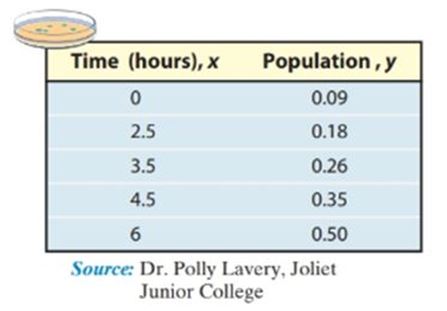
Concept explainers
Biology A strain of E-coli Beu 397-recA441 is placed into a nutrient broth at Celsius and allowed to grow. The following data are collected. Theory states that the number of bacteria in the petri dish will initially grow according to the law of uninhibited growth. The population is measured using an optical device in which the amount of light that passes through the petri dish is measured.

(a) Draw a
(b) Using a graphing utility, build an exponential model from the data.
(c) Express the function found in part (b) in the form .
(d) Graph the exponential function found in part (b) or (c) on the scatter diagram.
(e) Use the exponential function from part (b) or (c) to predict the population at hours.
(f) Use the exponential function from part (b) or (c) to predict when the population will reach .
To answer: The questions based on the given data in the table.
Answer to Problem 1AE
a. Scatter diagram.
Explanation of Solution
Given:
Table:
| Time (hours), | Population, |
| 0 | |
| 6 |
Calculation:
a. Scatter diagram.
Enter the data into the graphical utility, the time in and the population in , we obtain the scatter diagram as shown below.

To answer: The questions based on the given data in the table.
Answer to Problem 1AE
b. ;
Explanation of Solution
Given:
Table:
| Time (hours), | Population, |
| 0 | |
| 6 |
Calculation:
b.
The exponential function is of the form . Using the option of in the form , where and , proceed as follows:
;
To answer: The questions based on the given data in the table.
Answer to Problem 1AE
c.
Explanation of Solution
Given:
Table:
| Time (hours), | Population, |
| 0 | |
| 6 |
Calculation:
c.
To express in the form , where and , proceed as follows:
When , we find .
This leads to,
Therefore, .
Since, ; .
We find that and .
Taking log of the equation , we get,
As a result, .
To answer: The questions based on the given data in the table.
Answer to Problem 1AE
d. Graph.
Explanation of Solution
Given:
Table:
| Time (hours), | Population, |
| 0 | |
| 6 |
Calculation:
d.
See Figure 2 for the graph of the exponential function of best fit.

To answer: The questions based on the given data in the table.
Answer to Problem 1AE
e.
Explanation of Solution
Given:
Table:
| Time (hours), | Population, |
| 0 | |
| 6 |
Calculation:
e.
Using the function found in part-b, the population at hours can be predicted as,
This prediction exceeds the population at 6 hours.
To answer: The questions based on the given data in the table.
Answer to Problem 1AE
f. After hours.
Explanation of Solution
Given:
Table:
| Time (hours), | Population, |
| 0 | |
| 6 |
Calculation:
f.
Using the exponential form obtained in part-b, the time at which the population will reach can be obtained as,
Applying logarithm on both sides,
Therefore, after hours, the population will reach .
Want to see more full solutions like this?
Chapter 6 Solutions
College Algebra (10th Edition)
Additional Math Textbook Solutions
University Calculus
Elementary & Intermediate Algebra
Elementary Statistics (13th Edition)
Finite Mathematics for Business, Economics, Life Sciences and Social Sciences
Basic College Mathematics
- InThe Northern Lights are bright flashes of colored light between 50 and 200 miles above Earth. Suppose a flash occurs 150 miles above Earth. What is the measure of arc BD, the portion of Earth from which the flash is visible? (Earth’s radius is approximately 4000 miles.)arrow_forwarde). n! (n - 1)!arrow_forwardSuppose you flip a fair two-sided coin four times and record the result. a). List the sample space of this experiment. That is, list all possible outcomes that could occur when flipping a fair two-sided coin four total times. Assume the two sides of the coin are Heads (H) and Tails (T).arrow_forward
- e). n! (n - 1)!arrow_forwardEvaluate the following expression and show your work to support your calculations. a). 6! b). 4! 3!0! 7! c). 5!2! d). 5!2! e). n! (n - 1)!arrow_forwardAmy and Samiha have a hat that contains two playing cards, one ace and one king. They are playing a game where they randomly pick a card out of the hat four times, with replacement. Amy thinks that the probability of getting exactly two aces in four picks is equal to the probability of not getting exactly two aces in four picks. Samiha disagrees. She thinks that the probability of not getting exactly two aces is greater. The sample space of possible outcomes is listed below. A represents an ace, and K represents a king. Who is correct?arrow_forward
- Consider the exponential function f(x) = 12x. Complete the sentences about the key features of the graph. The domain is all real numbers. The range is y> 0. The equation of the asymptote is y = 0 The y-intercept is 1arrow_forwardThe graph shows Alex's distance from home after biking for x hours. What is the average rate of change from -1 to 1 for the function? 4-2 о A. -2 О B. 2 О C. 1 O D. -1 ty 6 4 2 2 0 X 2 4arrow_forwardWrite 7. √49 using rational exponents. ○ A. 57 47 B. 7 O C. 47 ○ D. 74arrow_forward
- Algebra & Trigonometry with Analytic GeometryAlgebraISBN:9781133382119Author:SwokowskiPublisher:Cengage
 Big Ideas Math A Bridge To Success Algebra 1: Stu...AlgebraISBN:9781680331141Author:HOUGHTON MIFFLIN HARCOURTPublisher:Houghton Mifflin Harcourt
Big Ideas Math A Bridge To Success Algebra 1: Stu...AlgebraISBN:9781680331141Author:HOUGHTON MIFFLIN HARCOURTPublisher:Houghton Mifflin Harcourt

